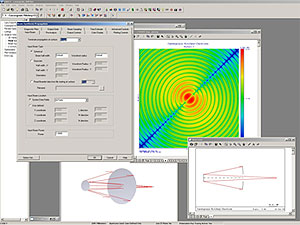
Code V 10.1
Synopsys Inc., Optical Solutions GroupRequest Info
Optical Design Software
PASADENA, Calif., July 20, 2009 – Code V 10.1, the newest release of the optical design software from Optical Research Associates, delivers tools that increase the accuracy and ease of use of the program’s diffraction analysis capabilities. Beam Synthesis Propagation (BSP), available in beta form in the previous Code V release, has already proven to be a widely applicable general diffraction beam propagation analysis tool that can deliver high-accuracy results with efficiency, saving the designer hours of system validation.
 Code V 10.1 brings the first formal release of BSP and expands it in several ways, with it now fully integrated in the software’s graphical user interface. Its “pre-analysis” feature recommends appropriate analysis controls based on the resident lens system. While pre-analysis makes BSP easy to use with minimal input, experts in beam propagation will have the flexibility to control virtually every aspect of the process. A BSP beamlet footprint diagnostic graphic is new in 10.1 and provides the designer with a simple visual way to assess the size and orientation of beamlets on any surface in the optical system. Also, fiber coupling efficiency analysis has been expanded to include vector field data from BSP.
Code V 10.1 brings the first formal release of BSP and expands it in several ways, with it now fully integrated in the software’s graphical user interface. Its “pre-analysis” feature recommends appropriate analysis controls based on the resident lens system. While pre-analysis makes BSP easy to use with minimal input, experts in beam propagation will have the flexibility to control virtually every aspect of the process. A BSP beamlet footprint diagnostic graphic is new in 10.1 and provides the designer with a simple visual way to assess the size and orientation of beamlets on any surface in the optical system. Also, fiber coupling efficiency analysis has been expanded to include vector field data from BSP.
This release features new capabilities for modeling real-world effects of mid-spatial-frequency surface errors on an optical surface. Such errors are typically encountered on surfaces fabricated using diamond turning or high-end polishing methods. Now the designer can describe component surface errors by specifying the parameters of a power spectral density. BSP is used to predict the diffracted image degradation caused by mid-spatial-frequency surface errors.
Code V 10.1 further enhances the program’s powerful automatic optimization feature with an alternative method of calculating variable change increments, which can improve the speed and quality of the optimization convergence. This approach benefits systems where the merit function is not strongly related to wavefront errors or surface sag, such as those involving a user-defined merit function or complex constraints.
For more information, visit: www.opticalres.com
Optical Research Associates
3280 E. Foothill Blvd.
Pasadena, CA, 91107
Phone: (626) 795-9101
Fax: (626) 795-0184
https://www.synopsys.com/optical-solutions.html
/Buyers_Guide/Synopsys_Inc_Optical_Solutions_Group/c10902
Published: July 2009
REQUEST INFO ABOUT THIS PRODUCT
* First Name:
* Last Name:
* Email Address:
* Company:
* Country:
Message:
When you click "Send Request", we will record and send your personal contact information to Synopsys Inc., Optical Solutions Group by email so they may respond directly. You also agree that Photonics Media may contact you with information related to this inquiry, and that you have read and accept our
Privacy Policy and
Terms and Conditions of Use.
Register or login to auto-populate this form:
Login
Register
* Required